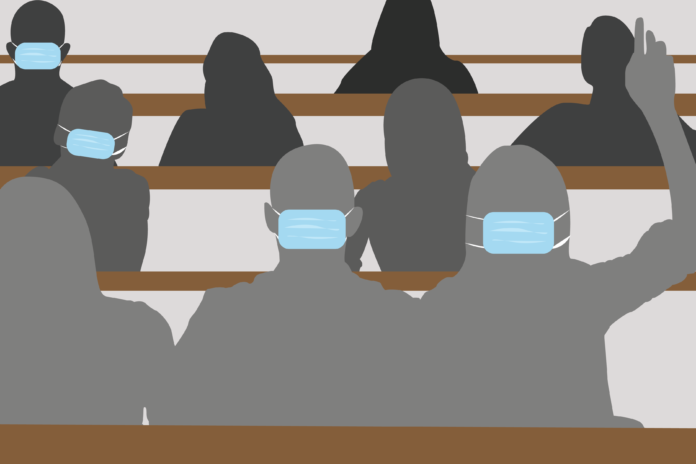We should not leave behind pandemic-era teaching methods that made education more flexible
By CLAIRE SCHAD — cfschad@ucdavis.edu
As the winter quarter continues to ramp up, there seems to be a steady increase in the number of sick students in my classes. The constant phlegmy coughs and stuffy noses seem to surround me in lecture halls and classrooms. I do my best to distance myself from those who seem the most audibly ill, but no matter what I do, I still overhear people discussing how terrible they feel.
And I know, I know, getting sick is pretty much inevitable as a college student, but it sucks nonetheless. But what makes it worse is having to attend classes while sick. But if I do decide to miss class and stay home and rest, I’m stressed about missing important course content. It feels like it’s only a matter of time before I face this dilemma again.
At the onset of the pandemic, everyone stayed home if they had any symptoms of illness. For the first time ever, many people were not plagued with the extreme guilt or anxiety of missing school or work when they were sick. It was almost as if people were finally seen as humans who needed to rest and put their health above all else. Despite how horrific this period was for many reasons, there was an understanding of the struggle we were all facing and the restructuring of priorities was refreshing.
Fast-forward to almost three years later, and most of these norms have been forgotten or abandoned completely. With college students back on campus during the height of seasonal illnesses, this is painfully apparent. Each time I sit in a crowded lecture hall surrounded by people who are obviously sick, I think about how it doesn’t have to be this way. We learned that there are ways to ensure students can access lecture material or employees can continue to work from home when they are ill. There are ways to limit the need to sit shoulder-to-shoulder with sick people.
With each deep cough I hear, the solution seems simpler and simpler — all lectures should be recorded, eliminating the need for students to come to class sick. Despite its obvious appeal, it seems that many professors choose to no longer offer recorded lectures, leaving students to suffer the consequences of circumstances they can’t control.
That said, I do understand that this opinion to increase the frequency of lecture recording is divisive — and with reason.
Often, students become disengaged and fall into a pattern of not attending class if the lecture is available to them to watch at their leisure. I’m sure we have all had that one lecture that seems endless and focuses on a topic you couldn’t care less about. To be honest, if it’s offered in a video or audio format online it’s a no-brainer — you’re not going to go. You’ll tell yourself you will watch it later, but that might not happen, and if it does, it might not be until you need to write a paper or study for an exam.
Low class attendance is a legitimate risk, but this too can be remedied; I’ve witnessed it in some of my courses. If attendance is encouraged through graded in-class activities, which can take the form of low-stakes free writes or answers to questions based on lecture material, lecture attendance can stay pretty high while still providing recordings after class.
By making these in-class activities worth a small part of the student’s grade, it incentivizes attendance without making it impossible for students that miss a class or two to do well. Throughout the pandemic, I had many professors that gave one or two “freebies” per quarter, meaning that if you missed a class or two, your grade would not be affected and anticipated absences were built into your grade. This allowed people to stay home when they were sick or had any other emergency, while still keeping up with the course content and doing well.
Not only do the options mentioned above take away some of the stress associated with being sick during college, but they also work to provide more resources for students to do well in their courses. If you are unsure about a specific topic or if you wanted to rewatch an example of a math problem completed in a lecture, a recording can be a great addition to your learning process. As long as lecture recordings aren’t provided as a replacement for in-class learning, they can be a great way to help students succeed.
The university already has a lot of infrastructure in place to support lecture recordings. There are over 120 classrooms across campus equipped with the lecture capture feature and directions on how to implement similar practices in the unequipped classrooms are available.
We all went through the dark days of Zoom chaos in the spring of 2020, but over the last three years, we have adapted and learned new ways to make learning easier for all. We must not abandon these useful tools we gained but rather continue to improve them and use them to increase the flexibility of higher education for all.
Written by: Claire Schad — cfschad@ucdavis.edu
Disclaimer: The views and opinions expressed by individual columnists belong to the columnists alone and do not necessarily indicate the views and opinions held by The California Aggie.






